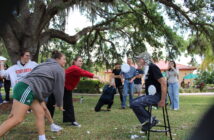
The new system has proved much easier for students to access and navigate than its predecessor
With the coming of the fall semester, Saint Leo has upgraded to a new ecosystem of learning management.
“For ten years, Saint Leo has been driving a 2007 Cadillac, and we are now moving to a 2016 Lexus Hybrid,” said Jeff Borden, the associate vice president for teaching and learning innovation, as he explained Saint Leo’s move from Pearson’s Learning Studio to Lion’s SHARE.
According to Borden, Desire to Learn, better known as D2L, is only one of the five key components of Lions SHARE that represents excellent technology for managing learning components.
“The entire system, all five tools, is being integrated so that students only feel like they are using a single system, but it’s actually all five combined that will replace Learning Studio,” Borden explains.
The Learning Management System (LMS) Committee is always finding new ways to update the system as well as to actively monitor student’s progress in class. It is not currently known what components or tools will be used in Lions SHARE, but the LMS Committee does have the student’s and faculty’s best interests at heart.
In the future, the LMS Committee hopes to build or add an Artificial Intelligence to Lion’s SHARE that can process a variety of possibilities for a professor to innovatively interact with their students and gain peripheral knowledge on their progress.
For instance, when a professor assigns group projects, the system could look into the experiences of student responses, grades, and other innumerable factors to determine who would be best suited to lead a class discussion and who would be better to process and gather information for a project.
“We will gain a ton of functionality and capacity that we never had at about 2/3 the cost. I just wanted to make that really clear,” Borden said.
Bugs and glitches are the most difficult things to avoid with any new piece of technology that comes out in the world, including that of D2L. Some of the bugs that some students have encountered with D2L are downloads of certain documents, such as PowerPoints or scans of certain pages within a text, and glitches with submissions to the drop box. Many of the things that some students have encountered, and may continue to see, are not exactly “glitches” or “bugs” but either a communication or a process issue.
Alicia Corts, an assistant professor of theater who was once a system administrator for D2L at the University of Georgia, believes that “It will take a while to learn this complicated system, but the benefits are worth it in the end.”
Sam Stokes, a senior history major, is just glad “that this new system is so easy to use.”
Borden commented that from the transactions that have occurred, less than 500 of them had been glitches, a .0005 percent chance that the problem may have indeed been a glitch. In that case, students and faculty should contact University Technology Services (UTS) should they experience any issues.
For the most part, both students and faculty are satisfied with the new changes that have come with the innovative new system. Hopefully, it will continue to make their time here at Saint Leo run a little more smoothly.




